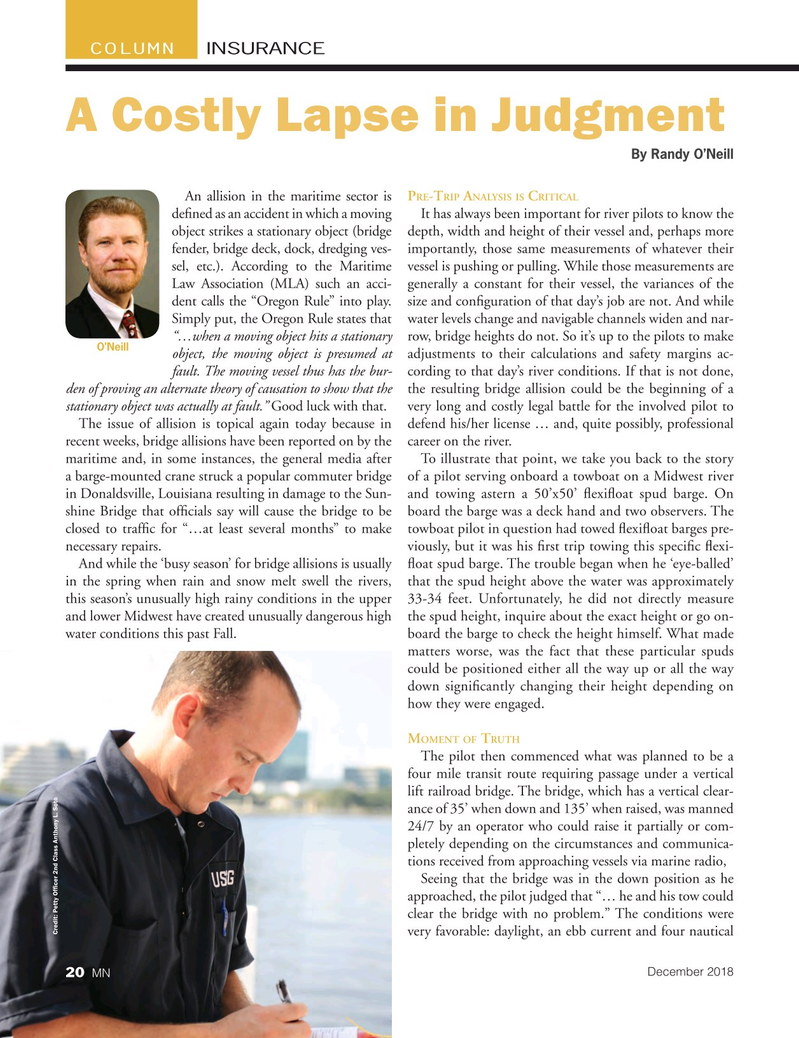
Page 20: of Marine News Magazine (December 2018)
Innovative Products & Boats
Read this page in Pdf, Flash or Html5 edition of December 2018 Marine News Magazine
COLUMN INSURANCE
A Costly Lapse in Judgment
By Randy O’Neill
An allision in the maritime sector is P -T A CRE RIP NALYSIS IS RITICAL de? ned as an accident in which a moving It has always been important for river pilots to know the object strikes a stationary object (bridge depth, width and height of their vessel and, perhaps more fender, bridge deck, dock, dredging ves- importantly, those same measurements of whatever their sel, etc.). According to the Maritime vessel is pushing or pulling. While those measurements are
Law Association (MLA) such an acci- generally a constant for their vessel, the variances of the dent calls the “Oregon Rule” into play. size and con? guration of that day’s job are not. And while
Simply put, the Oregon Rule states that water levels change and navigable channels widen and nar- “…when a moving object hits a stationary row, bridge heights do not. So it’s up to the pilots to make
O’Neill object, the moving object is presumed at adjustments to their calculations and safety margins ac- fault. The moving vessel thus has the bur- cording to that day’s river conditions. If that is not done, den of proving an alternate theory of causation to show that the the resulting bridge allision could be the beginning of a stationary object was actually at fault.” Good luck with that. very long and costly legal battle for the involved pilot to
The issue of allision is topical again today because in defend his/her license … and, quite possibly, professional recent weeks, bridge allisions have been reported on by the career on the river. maritime and, in some instances, the general media after To illustrate that point, we take you back to the story a barge-mounted crane struck a popular commuter bridge of a pilot serving onboard a towboat on a Midwest river in Donaldsville, Louisiana resulting in damage to the Sun- and towing astern a 50’x50’ ? exi? oat spud barge. On shine Bridge that of? cials say will cause the bridge to be board the barge was a deck hand and two observers. The closed to traf? c for “…at least several months” to make towboat pilot in question had towed ? exi? oat barges pre- necessary repairs. viously, but it was his ? rst trip towing this speci? c ? exi-
And while the ‘busy season’ for bridge allisions is usually ? oat spud barge. The trouble began when he ‘eye-balled’ in the spring when rain and snow melt swell the rivers, that the spud height above the water was approximately this season’s unusually high rainy conditions in the upper 33-34 feet. Unfortunately, he did not directly measure and lower Midwest have created unusually dangerous high the spud height, inquire about the exact height or go on- water conditions this past Fall. board the barge to check the height himself. What made matters worse, was the fact that these particular spuds could be positioned either all the way up or all the way down signi? cantly changing their height depending on how they were engaged.
M T
OMENT OF RUTH
The pilot then commenced what was planned to be a four mile transit route requiring passage under a vertical lift railroad bridge. The bridge, which has a vertical clear- ance of 35’ when down and 135’ when raised, was manned 24/7 by an operator who could raise it partially or com- pletely depending on the circumstances and communica- tions received from approaching vessels via marine radio,
Seeing that the bridge was in the down position as he approached, the pilot judged that “… he and his tow could clear the bridge with no problem.” The conditions were
Credit: Petty Of? cer 2nd Class Anthony L. Soto very favorable: daylight, an ebb current and four nautical
December 2018 20 MN
MN Dec18 Layout 18-31.indd 20 MN Dec18 Layout 18-31.indd 20 11/21/2018 1:23:35 PM11/21/2018 1:23:35 PM

 19
19

 21
21
